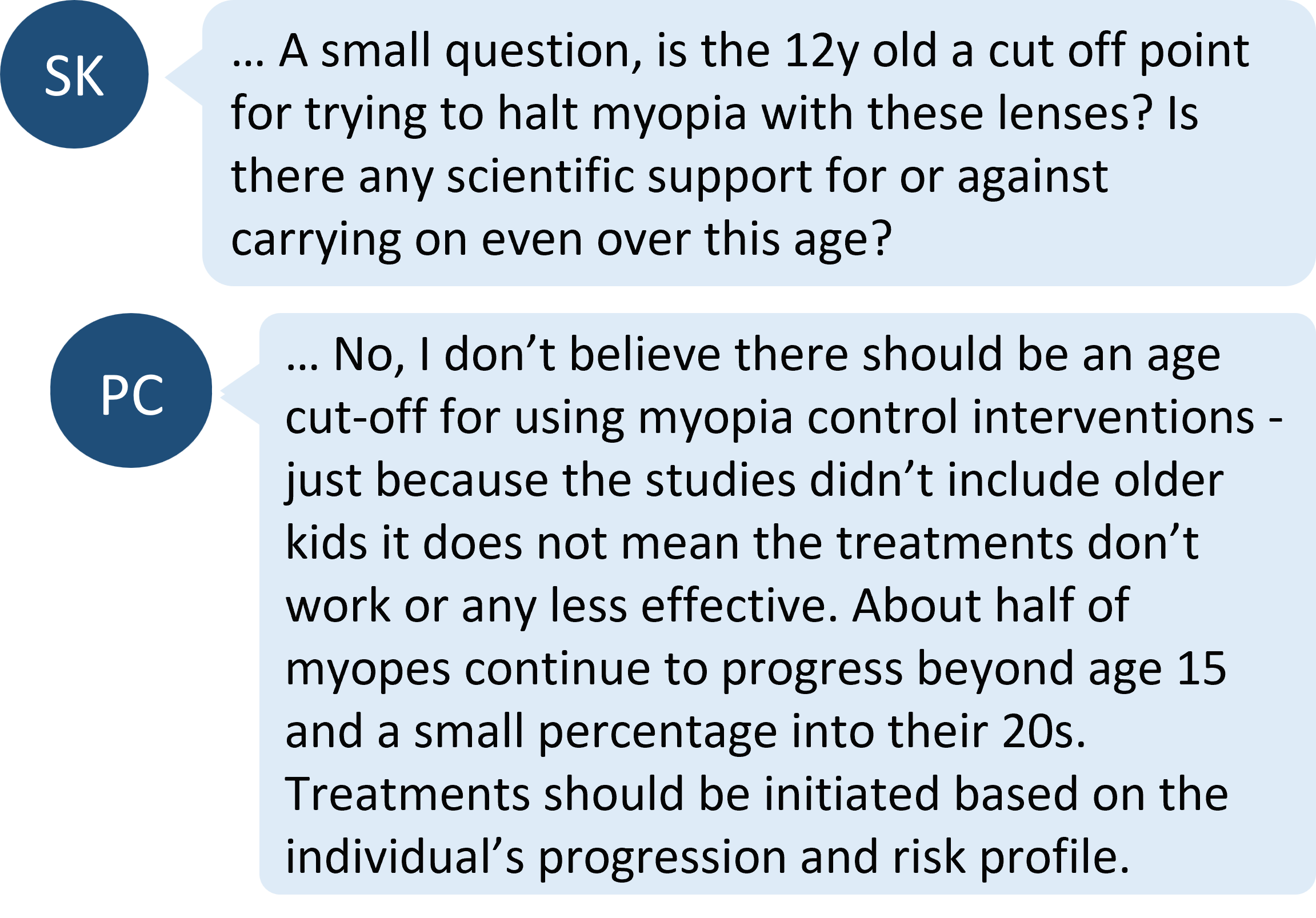Spectacle lens options for myopia management have evolved from progressive and bifocal lens options to the next generation of technology involving lenslets. These new technologies are showing myopia control efficacy at least equivalent with our best contact lens options and atropine concentrations, based on current data.1,2 Here, PC shared a case whereby his patient’s myopia is well controlled by one of these new technology spectacle lenses: the Highly Aspherical Lenslet Target or H.A.L.T. Technology lens, available as the Essilor® Stellest™ lens.

Comments from the Myopia Profile community

The global trends in myopia management attitudes and strategies in clinical practice show that fewer practitioners are prescribing single vision lenses and there is an increase in pharmaceutical and multifocal soft lens prescriptions. More practitioners are also now aware that under correction is not an effective method for myopia control.3
Question from the commenters
1. Should we stop myopia treatment at the age of 12?

The randomized controlled trial which investigated the Essilor Stellest spectacle lens recruited children aged 8-13 years at baseline, who after two years would have been 10-15 years: hence the evidence base covers children across this age range.1
At 12 years old, growth in children can be accelerating, with the most obvious example being their height. A study has shown axial length growth is correlated with body height. In addition, axial length growth accelerates faster in myopes compared to emmetropes.4
The COMET (progressive addition spectacle lens) study showed that 77% of myopes show refractive stability by the age of 18, whilst 90% of myopes stabilized by the age of 21.5 Hence, ceasing myopia management at 12 years old can be slightly too early. Read When To Stop Myopia Control Treatments to find out more.
2. Does a 0.25D change warrant a lens update?

From the comments, the general consensus is that a -0.25D change does not warrant a lens update as this most likely does not significantly affect vision or function. It is important to check this change with the patient and also perform the most accurate refraction possible to assess for change.
PC also makes an important point that axial length measurement changes can affirm whether or not a -0.25D change is true progression, or merely a factor of the margin of error with subjective refraction.
Take home messages
- Always start myopia intervention as early as possible to achieve the best outcomes.
- Myopia management strategies are generally best to be continued throughout childhood and into early adulthood until progression has plateaued, which is likely to be around or after age 21 in most people.
- A -0.25D change in subjective refraction may not warrant a spectacle lens update, dependent on the patient's experience of their vision. It is also useful to monitor the correlation between refractive error and axial length changes, to determine true progression of myopia compared to variability in refraction.
Further reading

About Connie
Connie Gan is a clinical optometrist from Kedah, Malaysia, who provides comprehensive vision care for children and runs the myopia management service in her clinical practice.

About Kimberley
Kimberley Ngu is a clinical optometrist from Perth, Australia, with experience in patient education programs, having practiced in both Australia and Singapore.
This content is brought to you thanks to an unrestricted educational grant from
![]()
References
- Bao J, Huang Y, Li X, Yang A, Zhou F, Wu J, Wang C, Li Y, Lim EW, Spiegel DP, Drobe B, Chen H. Spectacle Lenses With Aspherical Lenslets for Myopia Control vs Single-Vision Spectacle Lenses: A Randomized Clinical Trial. JAMA Ophthalmol. 2022 May 1;140(5):472-478. (link) [Link to Myopia Profile Science Summary]
- Brennan NA, Toubouti YM, Cheng X, Bullimore MA. Efficacy in myopia control. Prog Retin Eye Res. 2020 Nov 27:100923. (link) [Link to Myopia Profile paper review]
- Wolffsohn JS, Calossi A, Cho P, Gifford K, Jones L, Jones D, Guthrie S, Li M, Lipener C, Logan NS, Malet F. Global trends in myopia management attitudes and strategies in clinical practice–2019 Update. Contact Lens and Anterior Eye. 2020 Feb 1;43(1):9-17. Read more in: Myopia Control Prescribing Trends And Attitudes Across The World
- Kearney S, Strang NC, Cagnolati B, Gray LS. Change in body height, axial length and refractive status over a four-year period in caucasian children and young adults. Journal of Optometry. 2020 Apr 1;13(2):128-36. [Link to Myopia Profile Science Review]
- COMET Group. Myopia stabilization and associated factors among participants in the Correction of Myopia Evaluation Trial (COMET). Invest Ophthalmol Vis Sci. 2013 Dec;54(13):7871. (link)











